1920s India. Bishwambhar Roy (Chhabi Biswas) is the last in a line of zamindars who flourished in Bengal in the 19th century. However, their glorious past is long gone and Roy’s fortunes too are fast running out as he struggles to keep with the lifestyle of his ancestors by pawning the family jewels and to be up on his rich, upstart neighbor Mahim Ganguly (Gangapada Basu). For years now, Roy has precious little to do and has only one passion – holding extravagant musical performances in his opulent music room, flaunting whatever little remains of his wealth. Following the death of his wife and son in a storm, Roy withdraws onto complete seclusion. And when Ganguly invites him for a musical evening, he decides to upstage him with a grander concert that very evening…
Jalsaghar is Ray’s critique of a decadent colonial feudalism that was prevalent in nineteenth century Bengal and is perhaps Ray’s most evocative film, the Apu trilogy notwithstanding. The film, portraying the end of an era where feudal elite reclined amid silk cushions, smoking hookahs and drinking and patronizing the arts, is often compared to Guru Dutt’s masterpiece, Sahib Bibi aur Ghulam (1962), directed by Abrara Alvi, but to be fair to both, both films have their separate identities.
The film, examining the age-old conflict between the landed nobility and the unpedigreed rich, between those who dwell in the past and those who embrace the future, is based on two of Tarashankar Bandhopadhyay’s stories – Rabari and Jalsaghar. Wanting a change from the rural setting of his first two films Pather Panchali (1955) and Aparajito (1956), Ray made the satirical fantasy Paras Pathar (1957) and subsequently opted for this King Lear like tragedy before completing the ‘Apu trilogy’ with Apur Sansar (1959). The film was shot on the property of an actual zamindar at Nimita near the river Padma on the current border between India and Bangladesh and coincidentally the novelist had based his story on this very family!
While most of the film was shot on location, the key location of the music room however was a set constructed specially for the film as the original music room was not impressive enough. The highlight of the film are undoubtedly the three concert scenes with the appearance of leading Indian classical musicians and dancers like Akhtari Faizabadi (Begum Akhtar), Roshan Kumari, Waheed Khan and Shehnai maestro Ustad Bismillah Khan. But there was also a tragic aside to this. Since the set required overhead crane shots, a crane was hired for the shoot and at the end of its hire period as it was being loaded on to the truck it came crashing down killing one coolie and crippling another for life.
The life and soul of the film is undoubtedly Chhabi Biswas as the patriarch. Jalsaghar is undoubtedly his most memorable screen performance. As the zamindar whose passion for staging lavish musical entertainments brings about his ruin, he towers through every scene that he is in and shows exactly why he was such a favourite of Ray with whom he also worked in Devi (1960) and Kanchenjunga (1962). In fact, Ray admitted that after Biswas’s untimely demise in 1962, he has not written a single male middle-aged part that called for a high degree of professional talent. Playing opposite him perfectly as the crude and vulgar neighbour is Gangapada Basu. The other actors lend perfect support.
Jalsaghar is superbly enhanced by the evocative camerawork by Subrata Mitra who is regarded as perhaps the greatest ever Indian cinematographer. It was Mitra who revolutionized prevailing aesthetics in Indian Cinema with innovations designed to make lighting in Indian more realistic and poetic. Special mention must also be made of Ustad Vilayat Khan’s rousing music score and the splendid art direction by Bansi Changragupta, in particular the stunning mirrored dancing hall set.
All in all, Jalsaghar is a great film by a great filmmaker!
Bengali, Drama, Black & White


